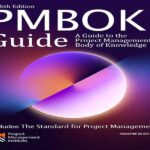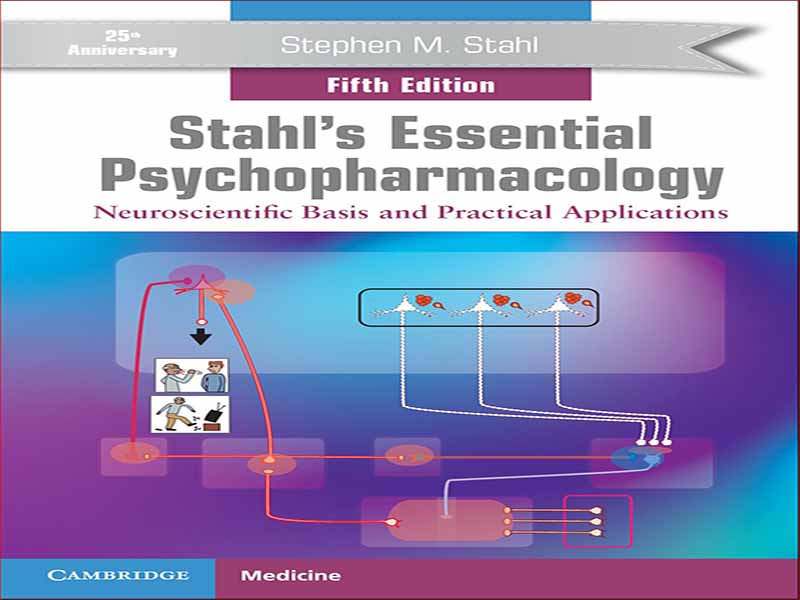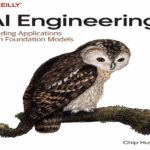- عنوان کتاب: Stahl’s Essential Psychopharmacology / Neuroscientific Basis and Practical Applications
- نویسنده: Stephen M. Stahl
- حوزه: فارماکولوژی
- سال انتشار: 2021
- تعداد صفحه: 640
- زبان اصلی: انگلیسی
- نوع فایل: pdf
- حجم فایل: 25.4 مگابایت
برای این نسخه پنجم از Stahl’s Essential Psychopharmacology، متوجه خواهید شد که هر شکل در کتاب با رنگها، سایهها و خطوط جدید تجدید نظر، تجدید و به روز شده است. حدود نیمی از ارقام کاملا جدید هستند. تعداد فصلها با ادغام تثبیتکنندههای خلقی در درمانهای اختلالات خلقی، یک فصل کاهش یافته است. خود متن و تعداد کل شکلها و جداول همگی از نظر طول و تعداد تقریباً یکسان هستند، اگرچه همه فصلها ویرایش شدهاند، اکثر آنها به طور گسترده، و جزئیات آنچه تغییر کرده است در زیر ذکر شده است. اکنون تعداد مراجع دو برابر شده است. در مجموع، 14 دارو دارای موارد مصرف و نشانه های ارائه شده جدید هستند و 18 داروی کاملاً جدید معرفی و مورد بحث قرار گرفته اند. نکات برجسته مواردی که از نسخه چهارم اضافه یا تغییر کرده است عبارتند از: • پوشش جدید RNA تداخلی (iRNA) در فصل های علوم اعصاب پایه • تجدید ساختار همه فصل ها برای منعکس کننده نامگذاری مبتنی بر علوم اعصاب، یعنی داروهایی که به دلیل مکانیسم عمل آنها به جای استفاده نامگذاری شده اند. بنابراین، داروهای افسردگی “ضد افسردگی” نیستند بلکه “مهارکننده های بازجذب مونوآمین با اثر ضد افسردگی” هستند. داروهای روان پریشی «ضد سایکوتیک» نیستند بلکه «آنتاگونیست های سروتونین/دوپامین با اثرات ضد روان پریشی» و غیره هستند. تجدید نظر در نظریه کلاسیک دوپامین روانپریشی • دو نظریه جدید روان پریشی (سروتونین و گلوتامات) • پوشش روانپریشی مرتبط با زوال عقل و سایکوز پارکینسون علاوه بر روان پریشی اسکیزوفرنی • پوشش به روز شده از نشانه های جدید داروهایی که قبلاً تأیید شده اند، از جمله لورازیدون، کاریپرازین، و برکسپیپرازول • پنج داروی جدید را برای روان پریشی شرح می دهد: لومات پرون تایید شده، و گزانوملین، پیماوانسرین، آگونیست های گیرنده مرتبط با آمین نوع 1 (TAAR1) و روپریدون در حال توسعه • داده های اتصال گیرنده به روز برای همه داروها • پوشش جدید دیسکینزی دیررس و جدید درمان های دارویی: دوترابنازین و والبنازین • پوشش جدید استفاده از داروهای سروتونین-دوپامین برای روان پریشی که امروزه حتی بیشتر برای افسردگی استفاده می شود. آمینو بوتیریک اسید الف) زیرگروههای گیرنده و محلهای اتصال نورواستروئید • پوشش جدید فاکتورهای رشد نوروتروفیک و نوروپلاستیسیته در افسردگی • پوشش جدید التهاب در افسردگی • تثبیتکنندههای خلقی باز تعریف شده • پوشش جدید/گسترش یافته لوومیلناسیپران، ورتیوکستین • پوشش جدید درمان شناخت در افسردگی • داروهای جدید: استروئیدهای عصبی، کتامین/اسکتامین، ترکیبات دکسترومتورفان، دکسترومتادون • پوشش گسترده ای از مقاومت درمانی و درمان های تقویت کننده برای مهارکننده های بازجذب مونوآمین از جمله برکسپیپرازول، کتامین، استکتامین، و کارآزمایی هایی با تغییرات جدید هیپوپلاستین هیپوپلاستیک، پیما وان به دنبال درمان آنتاگونیست NMDA (N-متیل-D-آسپارتات) با کتامین، اسکتامین، و سایر موارد • پوشش گسترده درمان افسردگی دوقطبی با نشانه های جدید و داروهای جدید لورازیدون، کاریپرازین • فصل اضطراب شامل: • حذف اختلال وسواس فکری-اجباری است. OCD) به فصل تکانشگری • پوشش اختلال استرس پس از سانحه (PTSD) به عنوان یک اختلال تروماتیک به جای اختلال اضطراب • تأکید بر علائم اضطراب به جای اختلالات اضطرابی • GABA به فصل خلق و خو منتقل شد • بحث های تجدید نظر شده در مورد درمان اختلالات اضطرابی فردی • تأکید مجدد در مورد ترکیب روان درمانی با روان درمانی برای علائم اضطراب • فصل درد دارای: • معیارهای جدید برای تشخیص فیبرومیالژیا • فصل خواب دارای: • پوشش بسیار گسترده ای از علوم اعصاب اورکسین • پوشش گسترده ای از علوم اعصاب هیستامین • پوشش بسیار گسترده ای از انتقال دهنده های عصبی در سراسر خواب/ چرخه بیداری • ارائه مفهوم سطوح آستانه متفاوت داروها با مکانیسم های مختلف به منظور القای خواب • پوشش گسترده آنتاگونیست های گیرنده اورکسین دوگانه از جمله یک عامل جدید لمبورکسانت • بحث در مورد آنتاگونیست هیستامین H3 جدید، پیتولیزانت، برای نارکولپسی • بحث در مورد یک جدید بازدارنده بازجذب نوراپی نفرین-دوپامین (NDRI)، سوریامفتول • گسترش بحث ریتم شبانه روزی • فصل اختلال کمبود توجه بیش فعالی (ADHD) شامل موارد زیر است: • پوشش فرمولاسیون های چندگانه دوز جدید متیل فنیدات و آمفتامین • بحث در مورد داروهای جدید افوریزون: ویلوکسازین و دیگران • ارائه مفهوم سطوح آستانه لازم برای اثربخشی محرک ها در ADHD • پوشش گسترده ای از رشد عصبی در ADHD • فصل زوال عقل دارای: • پوشش جدید گیرنده های استیل کولین و کولینرژیک • معرفی نظریه هایی برای مدارهای حافظه در مقابل روان پریشی در مقابل بی قراری در زوال عقل • عدم تاکید بر فرضیه آبشار آمیلوئید
For this fifth edition of Stahl’s Essential Psychopharmacology you will notice that every figure in the book has been revised, refreshed, and updated with new colors, shading, and outlining. About half the figures are entirely new. The number of chapters has decreased by one, with merger of mood stabilizers into treatments for mood disorders; the text itself and the total number of figures and tables are all approximately the same in length and number, although all chapters have been edited, most of them extensively, with the details of what has changed listed below. The number of references has now been doubled. Overall, 14 drugs have new uses and indications presented, and 18 brand new drugs are introduced and discussed. Highlights of what has been added or changed since the fourth edition include: • New coverage of interference RNA (iRNA) in basic neuroscience chapters • Restructuring all chapters to reflect neurosciencebased nomenclature, that is, drugs named for their mechanism of action rather than use • Thus, drugs for depression are not “antidepressants” but “monoamine reuptake inhibitors with antidepressant action”; drugs for psychosis are not “antipsychotics” but “serotonin/dopamine antagonists with antipsychotic actions,” etc. • The psychosis chapter has: • new coverage of the direct and indirect striatal dopamine pathways • new coverage of trace amines, receptors, and pharmacology • revision of the classic dopamine theory of psychosis • two new theories of psychosis (serotonin and glutamate) • coverage of dementia-related psychosis and Parkinson psychosis in addition to schizophrenia psychosis • updated coverage of new indications for drugs previously approved, including lurasidone, cariprazine, and brexpiprazole • describes five new drugs for psychosis: lumateperone approved, and xanomeline, pimavanserin, trace amine-associated receptor type 1 (TAAR1) agonists, and roluperidone in development • updated receptor binding data for all drugs • new coverage of tardive dyskinesia and new drug treatments: deutetrabenazine and valbenazine • new coverage of uses of serotonin–dopamine drugs for psychosis that are now used even more frequently for depression • The chapters on mood disorders have: • new coverage of mixed mood states • new coverage of GABAA (γ-aminobutyric acid A) receptor subtypes and neurosteroid binding sites • new coverage of neurotrophic growth factors and neuroplasticity in depression • new coverage of inflammation in depression • mood stabilizers redefined • new/expanded coverage of levomilnacipran, vortioxetine • new coverage of treating cognition in depression • new drugs: neuroactive steroids, ketamine/ esketamine, dextromethorphan combinations, dextromethadone • expanded coverage of treatment resistance and augmentation treatments for monoamine reuptake inhibitors including brexpiprazole, ketamine, esketamine, and trials with cariprazine, pimavanserin • expanded coverage of new hypotheses of neuroplastic downstream changes following NMDA (N-methyl-D-aspartate) antagonist therapy with ketamine, esketamine, and others • expanded coverage of treating bipolar depression with new indications and new drugs lurasidone, cariprazine • The anxiety chapter has: • removal of obsessive–complusive disorder (OCD) to the impulsivity chapter • coverage of posttraumatic stress disorder (PTSD) as a traumatic disorder rather than anxiety disorder • emphasis on anxiety symptoms rather than anxiety disorders • GABA moved to mood chapter • revised discussions on treatments of individual anxiety disorders • renewed emphasis on combining psychotherapy with psychopharmacology for symptoms of anxiety • The pain chapter has: • new criteria for fibromyalgia diagnosis • The sleep chapter has: • much expanded coverage of orexin neuroscience • expanded coverage of histamine neuroscience • much expanded coverage of neurotransmitters across the sleep/wake cycle • presentation of concept of different threshold levels of drugs of different mechanisms in order to induce sleep • expanded coverage of dual orexin receptor antagonists including a new agent lemborexant • discussion of new H3 histamine antagonist, pitolisant, for narcolepsy • discussion of a new wake-promoting norepinephrine–dopamine reuptake inhibitor (NDRI), solriamfetol • expanded circadian rhythm discussion • The attention deficit hyperactivity disorder (ADHD) chapter has: • coverage of multiple new dosage formulations of methylphenidate and amphetamine • discussion of new drugs on the horizon: viloxazine, and others • a presentation of concept of threshold levels necessary for efficacy of stimulants in ADHD • expanded coverage of neurodevelopment in ADHD • The dementia chapter has: • new coverage of acetylcholine and cholinergic receptors • introduction of theories for the circuits of memory versus psychosis versus agitation in dementia • de-emphasis of the amyloid cascade hypothesis
این کتاب را میتوانید از لینک زیر بصورت رایگان دانلود کنید:
Download: Stahl’s Essential Psychopharmacology




































نظرات کاربران